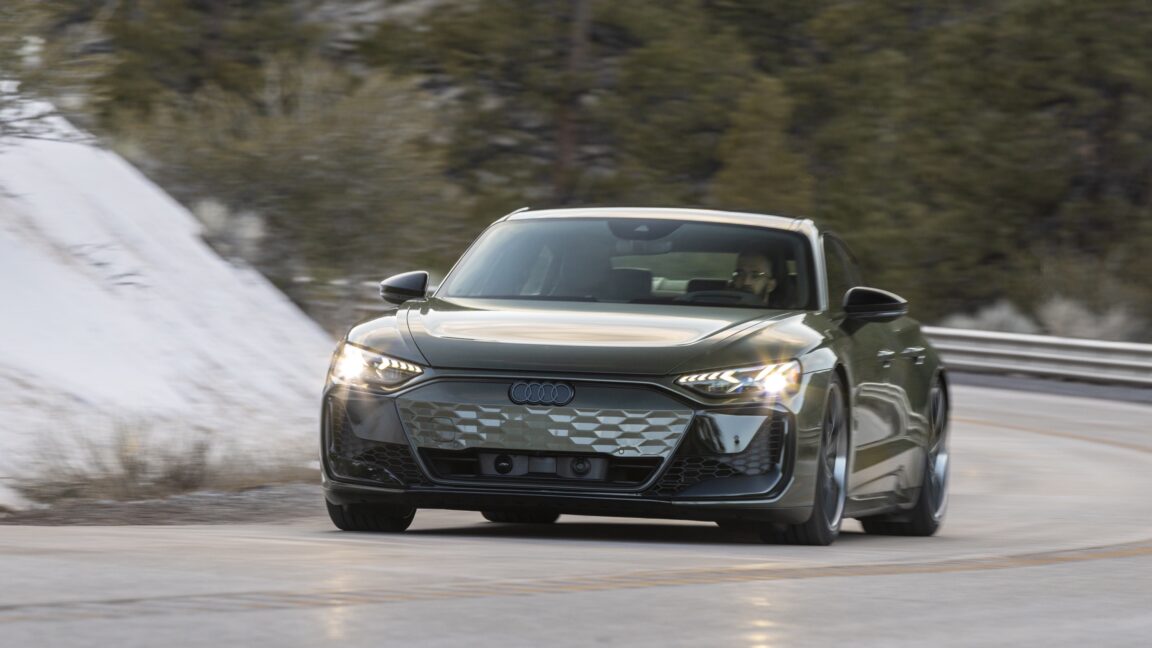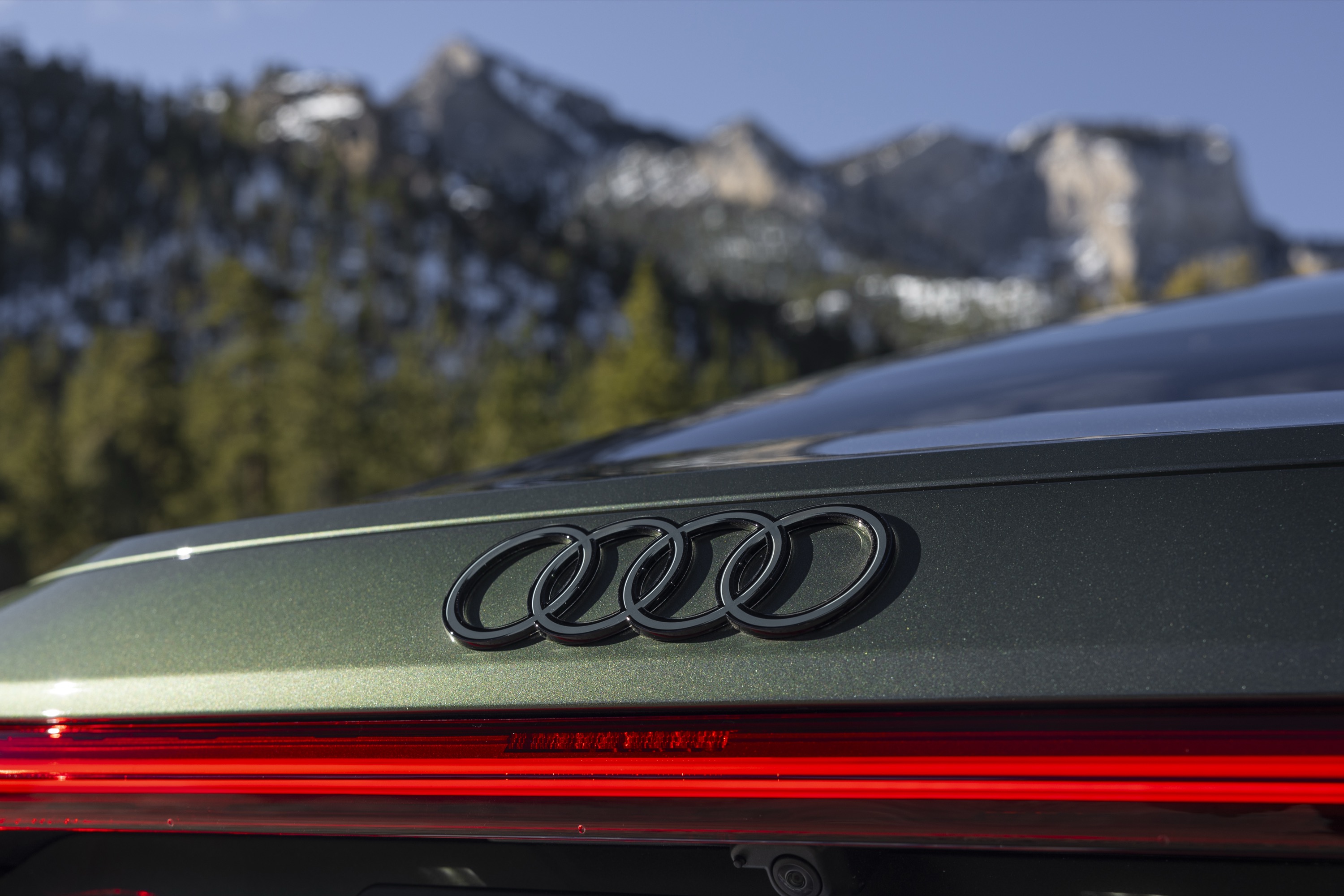
Credit: Audi
LAS VEGAS—Audi's sleek four-door electric sedan, the e-tron GT, has just received its midlife refresh. Usually, a midlife refresh is mostly cosmetic, intended to prevent the model from feeling too stale in the marketplace. But this time Audi has kept the visual changes to a minimum. There are new wheels and a new interior, as well as redesigned front and rear fascias, although the changes are quite subtle. Instead, there's been a comprehensive reengineering effort under the skin.
Perhaps not quite as comprehensive as the Polestar 2 refresh—which swapped front-wheel drive for rear—but there are now new motors and a new battery pack, which bring with them increased range, a reduced 0–60 mph time, and even faster fast-charging. Audi says it has also worked on the driving dynamics, including adding the same active suspension system we recently experienced in the Porsche Panamera.
As before, the e-tron GT comes in two specifications, but now the base model is the $125,500 S e-tron GT. This now offers 670 hp (500 kW), a 148 hp (110 kW) improvement on last year's model. That drops the 0–60 mph time from 4 seconds down to 3.3, but the 51-mile ( 82 km) increase to its range—now 300 miles (482 km) on a single charge—is probably going to be the most enticing improvement for potential buyers. That's courtesy of a new 105 kWh (gross, 97 kWh usable) battery.
Audi didn't have any S e-tron GTs in Las Vegas for us to try, so we had to make do with the RS e-tron GT, which starts at $167,999—$20,000 more than the 2024 version. But you do get quite a lot extra for that. Peak power is up to 912 hp (680 kW), although only in launch mode or if you push the boost control button. But nominal power is around 750 hp (560 kW), 113 hp (85 kW) more than before. That cuts the 0–60 time to just 2.4 seconds, or perhaps faster—one of the other journalists on the drive brought testing instrumentation and logged a 2.1 second 0–60 time. So Audi isn't joking when it says this is the fastest car it has ever built.
New motors, new battery
The front electric motor has revised electronics and a new pulse inverter, and the rear motor is a new version with a higher density of copper windings and an overall weight reduction of 22 lbs (10 kg). They've upped the amount of regenerative braking on offer, too—you can now harvest up to 400 kW under braking at up to 0.45 G before the friction brakes take over (the old car was up to 290 kW and 0.38 G). Audi also upped the maximum amount of regen braking that occurs when you lift off the throttle, which can now be 0.13 G (up from 0.06 G), which you toggle on or off using the paddles behind the steering wheel.
Being able to recover more energy under braking obviously helps efficiency, but there's also new battery chemistry with a different ratio of nickel:manganese:cobalt from before, plus a lot of work on the 800 V battery pack's cooling system. That also means it can DC fast-charge at up to 320 kW now, which drops the 10–80 percent charge time to just 18 minutes, making the e-tron GT competitive with the very fast-charging EVs from Kia, Hyundai, and Genesis. The optimum pack temperature for fast charging has been reduced from 95° C to 59° C, and the pack even weighs 25 lbs (11 kg) less than before.
For an extra $11,000, you can equip the RS e-tron GT with active suspension (together with better performance tires and ceramic brakes in the Dynamic plus package). If you choose comfort mode, the active suspension will lean into turns, lift the nose under braking, and drop the nose under acceleration, combating the weight transfer that happens under cornering, acceleration, and braking. With this setting active, and when driven at regular speeds, the effect is a subtle but indeed very comfortable ride as a passenger.
I’m going HOW fast??
As you settle into the seat of the RS e-tron GT, you notice there's a new multifunction steering wheel, with a pair of bright red buttons—one to activate the 10-second boost mode, the other to toggle between the two customizable "RS" drive modes and performance mode (to switch between comfort, dynamic, and efficiency, you use a button on the center stack). There's also new Nappa leather for the seats, and the option of forged carbon fiber trim as opposed to the woven stuff. Oddly, the forged carbon is an $8,400 add-on, despite being cheaper and easier to make than traditional woven carbon fiber. There's also the option of an all-carbon fiber roof, or a glass roof with or without electrochromic dimming sections.
On the road, the RS e-tron GT is rather refined, particularly in comfort mode. As mentioned, with the active suspension doing its active comfort thing, the ride as a passenger is particularly good. From behind the wheel, you discover it's rather more rapid than you might think, in part due to the lack of drama or noise. In fact, if you're not careful you might find yourself going 15–20 mph faster than you thought, at which point the wind noise from the A pillar picks up somewhat.
At road legal speeds, the car is so far within its performance envelope that its front grip might as well be unlimited. It's very stable, and like the old model absolutely adores sweeping corners, onramps, and the like, although without much in the way of feedback from the steering. This proved equally true during a short track session later that evening, where we could explore some of the further reaches of the e-tron GT's abilities. Launch control is easy to engage—just keep your left foot on the brake, then your right on the throttle, then lift off the brake—and will see the car shimmy and wiggle a bit as the four tires try to send almost a thousand horsepower to the road surface.
That's about as close as it comes to being exciting, rather than composed. It's a trait that's shared by some but not all RS-badged Audis; the RS6 Avant wagon will put more of a smile on your face than the RS7 Sportback, or this EV, for instance.

This, or a less powerful Porsche Taycan?
Credit: Audi
The RS e-tron GT is very competent, and very Audi in its driving experience—which is a good thing, because for most non-Audi fans, it might be quite hard to avoid picking the Porsche Taycan over one of these. The Taycan received its own refresh recently, and although you'll pay more for a Taycan Turbo that has less power and a slower 0–60 than this RS, it's hard to deny that the Porsche badge has an extra level of cachet for many.

-
 C114 Communication Network
C114 Communication Network -
 Communication Home
Communication Home


